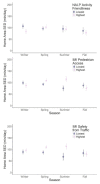The Effect of Season and Neighbourhood-Built Environment on Home Area Sedentary Behaviour in 9-14 Year Old Children
- PMID: 33670599
- PMCID: PMC7922005
- DOI: 10.3390/ijerph18041968
The Effect of Season and Neighbourhood-Built Environment on Home Area Sedentary Behaviour in 9-14 Year Old Children
Abstract
There is little understanding of how the built environment shapes activity behaviours in children over different seasons. This study sought to establish how seasonal weather patterns, in a given year in a mid-western Canadian city, affect sedentary time (SED) in youth and how the relationship between season and SED are moderated by the built environment in their home neighbourhood. Families with children aged 9-14 years were recruited from the prairie city of Saskatoon, Canada. Location-specific, device-based SED was captured in children during three timeframes over a one-year period using GPS-paired accelerometers. Multilevel models are presented. Children accumulated significantly greater levels of SED in spring but significantly less SED in the fall months in comparison to the winter months. Children living in neighbourhoods with the highest density of destinations accumulated significantly less SED while in their home area in comparison to their counterparts, and this effect was more pronounced in the spring and summer months. On weekends, the rise in sedentariness within the home area was completely diminished in children living in neighbourhoods with the greatest number of destinations and highest activity friendliness. These results suggested that increasing neighbourhood amenities can lead to a reduced sedentariness of youth, though more so in the warmers months of the year.
Keywords: adolescents; built environment; children; physical activity; physical behaviour; season; sedentary behaviour; sedentary time.
Conflict of interest statement
The authors declare no conflict of interest. The funders had no role in the design of the study; in the collection, analyses, or interpretation of data; in the writing of the manuscript, or in the decision to publish the results.
Figures



Similar articles
-
Longitudinal active living research to address physical inactivity and sedentary behaviour in children in transition from preadolescence to adolescence.BMC Public Health. 2015 May 17;15:495. doi: 10.1186/s12889-015-1822-2. BMC Public Health. 2015. PMID: 25981556 Free PMC article.
-
Smart cities, healthy kids: the association between neighbourhood design and children's physical activity and time spent sedentary.Can J Public Health. 2012 Jul 26;103(9 Suppl 3):eS22-8. doi: 10.1007/BF03403831. Can J Public Health. 2012. PMID: 23618084 Free PMC article.
-
The proportion of youths' physical inactivity attributable to neighbourhood built environment features.Int J Health Geogr. 2013 Jun 18;12:31. doi: 10.1186/1476-072X-12-31. Int J Health Geogr. 2013. PMID: 23777593 Free PMC article.
-
Workplace neighbourhood built environment and workers' physically-active and sedentary behaviour: a systematic review of observational studies.Int J Behav Nutr Phys Act. 2020 Nov 20;17(1):148. doi: 10.1186/s12966-020-01055-x. Int J Behav Nutr Phys Act. 2020. PMID: 33218343 Free PMC article.
-
Annual, seasonal, cultural and vacation patterns in sleep, sedentary behaviour and physical activity: a systematic review and meta-analysis.BMC Public Health. 2021 Jul 13;21(1):1384. doi: 10.1186/s12889-021-11298-3. BMC Public Health. 2021. PMID: 34256712 Free PMC article.
Cited by
-
Identifying risk profiles for excess sedentary behaviour in youth using individual, family and neighbourhood characteristics.Prev Med Rep. 2021 Aug 28;24:101535. doi: 10.1016/j.pmedr.2021.101535. eCollection 2021 Dec. Prev Med Rep. 2021. PMID: 34987952 Free PMC article.
-
Associations of perceived neighbourhood and home environments with sedentary behaviour among adolescents in 14 countries: the IPEN adolescent cross sectional observational study.Int J Behav Nutr Phys Act. 2024 Nov 29;21(1):136. doi: 10.1186/s12966-024-01678-4. Int J Behav Nutr Phys Act. 2024. PMID: 39614267 Free PMC article.
References
-
- World Health Organization Physical Inactivity: A Global Public Health Problem. [(accessed on 21 June 2017)]; Available online: http://www.who.int/dietphysicalactivity/factsheet_inactivity/en/
-
- Tremblay M.S., Barnes J.D., Gonzalez S.A., Katzmarzyk P.T., Onywera V.O., Reilly J.J., Tomkinson G.R., Team G.M. 2 0 R. Global matrix 2.0: Report card grades on the physical activity of children and youth comparing 38 countries. J. Phys. Act. Health. 2016;13:S343–S366. doi: 10.1123/jpah.2016-0594. - DOI - PubMed
Publication types
MeSH terms
Grants and funding
LinkOut - more resources
Full Text Sources
Other Literature Sources
Medical

